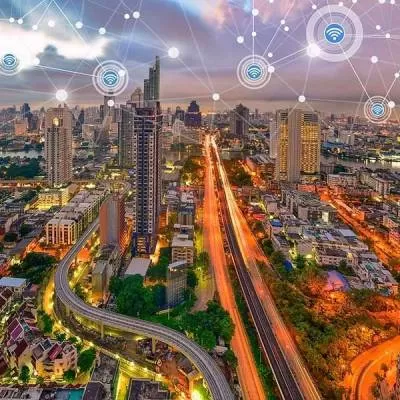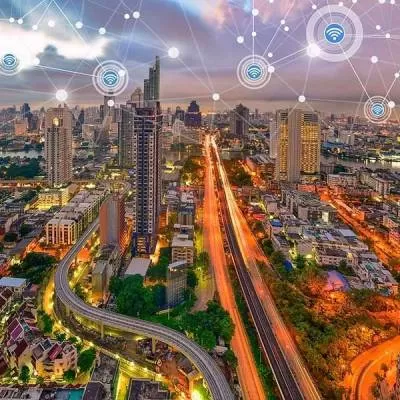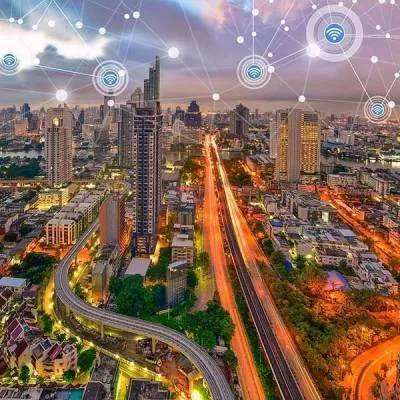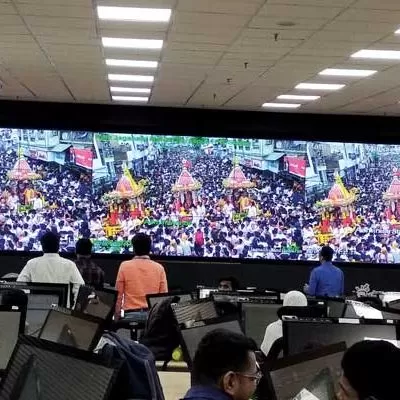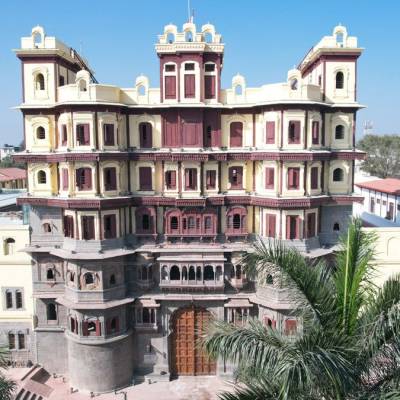- Home
- Infrastructure Urban
- SMART CITIES
- Through the Smart City Challenge proposal, we will further ensure the city remains dynamic to sustainable growth

Through the Smart City Challenge proposal, we will further ensure the city remains dynamic to sustainable growth
After suffering the devastating Hudhud cyclone, the financial capital of Andhra Pradesh, Visakhapatnam, also called Vizag, has begun to walk the path of re-establishing itself to make life beautiful for its cosmopolitan mix of people. A key player in various sectors of IT, fishing, pharmaceuticals, trade and others, Vizag is making a comeback in terms of its civic amenities by paving its way to the list of the 98 selected cities under the smart cities mission. Pravin Kumar, Commissioner, Greater Vishakhapatnam Municipal Corporation (GVMC), shares his vision and plans to help the city achieve the status of a ´smart city´ that it always deserved.
What is the vision document to make the city smarter?
GVMC understands the smart cities mission and its requirements. We have formulated a comprehensive strategy to engage citizens in the planning process and create opportunities to know their aspirations for Vizag.
To establish the Smart Vizag vision, we conducted around 17 sector-specific focus group meetings, which included participation from both public and private sectors to share their views and ideas on city planning, environment, disaster management, infrastructure, sanitation and solid waste management, e-governance, education and health, to name a few.
We have used social media tools extensively to know the vision and priorities of citizens. We have initiated a vision statement competition on MyGov.in; initiated a priority listing exercise and a questionnaire to be answered by Vizag citizens. We have collected feedback from students of higher education schools and households and we plan to collect feedback from 100,000 households in the city. This will be analysed and the assessment, used to establish a ´co-produced´ vision for the city. A Smart Vizag vision will facilitate the inception of a Smart City Challenge proposal that will be embedded in reality and innovation. Projects implemented as part of this challenge will be scalable and replicable throughout the city.
What are the challenges faced?
The challenge is to identify the right projects pan-city initiative and area-wide plan such that they are clearly linked to budgetary allocations and endorsed by citizens. We are working in tandem with government departments and advisors to draft a good proposal.
Vizag is identified as one of the fastest-growing cities in the world, economically and demographically....
Vizag already has all the right ingredients to continue on the path of sustainable growth. We are a resilient city and our citizens value and nurture nature. Through the proposal, we will further ensure that the city remains dynamic to sustainable growth; engage citizens in determining the city´s future; provide a safe and secure environment for the people; focus on job creation for all; and maximise a business-friendly environment for national and international enterprises.
What is the city´s contribution to initiatives such as Make in India and the Swachh Bharat Abhiyan?
Under the Smart Cities Challenge, various types of projects can be implemented under one identified area and then tied back to other efforts of the Central Government like Make in India, where international players are called upon to come forward and set up their manufacturing facility in India, such that a considerable number of local jobs are made available and overall skill development for trained manpower for industries is initiated. A solid waste management (SWM) programme can link back to the Swachh Bharat Abhiyan. GVMC has already taken up a SWM strategy. To synchronise with the system of primary collection and bulk waste storage, rickshaws and containerised handcarts have been provided all over the city. Source segregation of garbage and waste has been introduced and 90 per cent of the city has been covered. Initiatives include door-to-door waste collection, a 24/7 sanitation programme in selected areas, night sanitation in major roads and the supply of 45,000 red and green dustbins for non-biodegradable and biodegradable waste collection. Future plans include DPR preparation for SWM as per its rules, a waste-to-energy plant, incineration plants, RDF facilities and less emphasis on landfill, procurement of compactors and street sweeping machines.
Tell us about the comprehension action plan on ensuring basic infrastructure under AMRUT?
Basic infrastructure services under the AMRUT scheme cover water supply, sewerage, public transportation, households and building of city amenities to improve quality of life for citizens. We have made our suggestions, which are being incorporated in the State Annual Action Plan, which in turn will be reviewed by the Ministry of Urban Development.
Tell us about the upcoming projects for the city´s infrastructure?
Water supply distribution lines in old town area, Gajuwaka area, 32 villages and central area are under progress; the DPR for northwest area is under finalisation. Reuse of wastewater by tertiary treatment, a desalination plant and a pipeline from Yeleswaram are some future plans to augment water supply. Besides, renewal of BT roads, restoration of pedestrian walkways with tiling and improvement, upgrade and beautification of 20 major identified roads and completion of BRTS corridor are some developments to improve road mobility. Also, for improvement of the drainage system, we are targeting regulation of beach sullage drains along Beach Road, improvement of major geddas and nalas, interception of storm-water drains and installation of mini-treatment plants, and comprehensive drainage system in the old city. Under JNNURM, 14 works have been taken up for urban infrastructure development with a total project cost of Rs 1,609 crore and 21 works for urban poor at a cost of Rs 537 crore.
What is the budget allotted for that city under the smart cities mission?
Under the smart cities initiative, the centre will allocate Rs 100 crore and the state will extend another Rs 100 crore per year, for a period of five years; this is the assured funding.
Apart from this, the SPV formed for project implementation can raise its own funds by borrowing from bilateral agencies and PPP initiatives.
Are there any measures to ensure that the city withstands a disaster like Hudhud in future?
The cyclone and its impact are unforgettable. The city´s devastation is a case study to establish a process of relief operations and understand disaster management and rehabilitation as well as disaster prevention. Infrastructure has to be resilient to withstand and respond to future disasters. We are developing underground cabling without any pole on the surface, which will prevent interruption of essential services like power, water and communications. In the recent smart city vision formulation, top priority has been given to disaster prevention and planning.
Please share some positive developments.
Post hudhud, the entire street-lighting system in the GVMC had collapsed, leaving the city in darkness. This has given birth to an LED lighting system in place of SV lamps and tube-lights. Nearly 1 lakh conventional lights are being replaced by LED fixtures, without any capital cost involved in the new system. Further, public information and grievance redressal processes have been implemented through electronic service delivery. Officers have been made accountable and answerable to the public through IVRS, Facebook, ´Dial Your Commissioner´ and other web-based services. Information related to financial and policy matters has been placed in the public domain to improve transparency and accountability. Another effective measure has been the establishment of a cyclone zone on Beach Road without motorised vehicles to encourage walkers and create awareness on environment and pollution control. Besides, every Monday has been declared to be a vehicle-free day in the GVMC office to save fuel and promote health. This has been happening successfully for over a year.
VIZAG city
.......................................................
Year of establishment: 1866
Total city area: 620 sq km
Population: 18.83 lakh
Density: 3,319 sq km
Decadal growth rate: 91 per cent
Administration zones: 8 zones
Ward offices: 72
Civic centres: 8
Annual budget: Rs.2,103 crore
- Pravin Kumar, Commissioner, Greater Visakhapatnam Municipal Corporation After suffering the devastating Hudhud cyclone, the financial capital of Andhra Pradesh, Visakhapatnam, also called Vizag, has begun to walk the path of re-establishing itself to make life beautiful for its cosmopolitan mix of people. A key player in various sectors of IT, fishing, pharmaceuticals, trade and others, Vizag is making a comeback in terms of its civic amenities by paving its way to the list of the 98 selected cities under the smart cities mission. Pravin Kumar, Commissioner, Greater Vishakhapatnam Municipal Corporation (GVMC), shares his vision and plans to help the city achieve the status of a ´smart city´ that it always deserved. What is the vision document to make the city smarter? GVMC understands the smart cities mission and its requirements. We have formulated a comprehensive strategy to engage citizens in the planning process and create opportunities to know their aspirations for Vizag. To establish the Smart Vizag vision, we conducted around 17 sector-specific focus group meetings, which included participation from both public and private sectors to share their views and ideas on city planning, environment, disaster management, infrastructure, sanitation and solid waste management, e-governance, education and health, to name a few. We have used social media tools extensively to know the vision and priorities of citizens. We have initiated a vision statement competition on MyGov.in; initiated a priority listing exercise and a questionnaire to be answered by Vizag citizens. We have collected feedback from students of higher education schools and households and we plan to collect feedback from 100,000 households in the city. This will be analysed and the assessment, used to establish a ´co-produced´ vision for the city. A Smart Vizag vision will facilitate the inception of a Smart City Challenge proposal that will be embedded in reality and innovation. Projects implemented as part of this challenge will be scalable and replicable throughout the city. What are the challenges faced? The challenge is to identify the right projects pan-city initiative and area-wide plan such that they are clearly linked to budgetary allocations and endorsed by citizens. We are working in tandem with government departments and advisors to draft a good proposal. Vizag is identified as one of the fastest-growing cities in the world, economically and demographically.... Vizag already has all the right ingredients to continue on the path of sustainable growth. We are a resilient city and our citizens value and nurture nature. Through the proposal, we will further ensure that the city remains dynamic to sustainable growth; engage citizens in determining the city´s future; provide a safe and secure environment for the people; focus on job creation for all; and maximise a business-friendly environment for national and international enterprises. What is the city´s contribution to initiatives such as Make in India and the Swachh Bharat Abhiyan? Under the Smart Cities Challenge, various types of projects can be implemented under one identified area and then tied back to other efforts of the Central Government like Make in India, where international players are called upon to come forward and set up their manufacturing facility in India, such that a considerable number of local jobs are made available and overall skill development for trained manpower for industries is initiated. A solid waste management (SWM) programme can link back to the Swachh Bharat Abhiyan. GVMC has already taken up a SWM strategy. To synchronise with the system of primary collection and bulk waste storage, rickshaws and containerised handcarts have been provided all over the city. Source segregation of garbage and waste has been introduced and 90 per cent of the city has been covered. Initiatives include door-to-door waste collection, a 24/7 sanitation programme in selected areas, night sanitation in major roads and the supply of 45,000 red and green dustbins for non-biodegradable and biodegradable waste collection. Future plans include DPR preparation for SWM as per its rules, a waste-to-energy plant, incineration plants, RDF facilities and less emphasis on landfill, procurement of compactors and street sweeping machines. Tell us about the comprehension action plan on ensuring basic infrastructure under AMRUT? Basic infrastructure services under the AMRUT scheme cover water supply, sewerage, public transportation, households and building of city amenities to improve quality of life for citizens. We have made our suggestions, which are being incorporated in the State Annual Action Plan, which in turn will be reviewed by the Ministry of Urban Development. Tell us about the upcoming projects for the city´s infrastructure? Water supply distribution lines in old town area, Gajuwaka area, 32 villages and central area are under progress; the DPR for northwest area is under finalisation. Reuse of wastewater by tertiary treatment, a desalination plant and a pipeline from Yeleswaram are some future plans to augment water supply. Besides, renewal of BT roads, restoration of pedestrian walkways with tiling and improvement, upgrade and beautification of 20 major identified roads and completion of BRTS corridor are some developments to improve road mobility. Also, for improvement of the drainage system, we are targeting regulation of beach sullage drains along Beach Road, improvement of major geddas and nalas, interception of storm-water drains and installation of mini-treatment plants, and comprehensive drainage system in the old city. Under JNNURM, 14 works have been taken up for urban infrastructure development with a total project cost of Rs 1,609 crore and 21 works for urban poor at a cost of Rs 537 crore. What is the budget allotted for that city under the smart cities mission? Under the smart cities initiative, the centre will allocate Rs 100 crore and the state will extend another Rs 100 crore per year, for a period of five years; this is the assured funding. Apart from this, the SPV formed for project implementation can raise its own funds by borrowing from bilateral agencies and PPP initiatives. Are there any measures to ensure that the city withstands a disaster like Hudhud in future? The cyclone and its impact are unforgettable. The city´s devastation is a case study to establish a process of relief operations and understand disaster management and rehabilitation as well as disaster prevention. Infrastructure has to be resilient to withstand and respond to future disasters. We are developing underground cabling without any pole on the surface, which will prevent interruption of essential services like power, water and communications. In the recent smart city vision formulation, top priority has been given to disaster prevention and planning. Please share some positive developments. Post hudhud, the entire street-lighting system in the GVMC had collapsed, leaving the city in darkness. This has given birth to an LED lighting system in place of SV lamps and tube-lights. Nearly 1 lakh conventional lights are being replaced by LED fixtures, without any capital cost involved in the new system. Further, public information and grievance redressal processes have been implemented through electronic service delivery. Officers have been made accountable and answerable to the public through IVRS, Facebook, ´Dial Your Commissioner´ and other web-based services. Information related to financial and policy matters has been placed in the public domain to improve transparency and accountability. Another effective measure has been the establishment of a cyclone zone on Beach Road without motorised vehicles to encourage walkers and create awareness on environment and pollution control. Besides, every Monday has been declared to be a vehicle-free day in the GVMC office to save fuel and promote health. This has been happening successfully for over a year. VIZAG city ....................................................... Year of establishment: 1866 Total city area: 620 sq km Population: 18.83 lakh Density: 3,319 sq km Decadal growth rate: 91 per cent Administration zones: 8 zones Ward offices: 72 Civic centres: 8 Annual budget: Rs.2,103 crore


